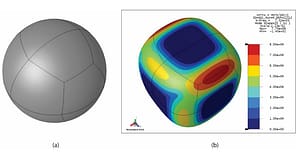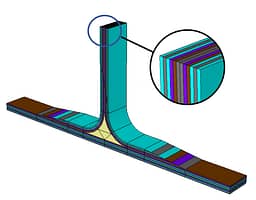
By Dr. Barna Szabó
Engineering Software Research and Development, Inc.
St. Louis, Missouri USA
Digital transformation is a multifaceted concept with plenty of room for interpretation. Its common theme emphasizes the proactive adoption of digital technologies to reshape business practices with the goal of gaining a competitive edge. The scope, timeline, and resource allocation of digital transformation projects depend on the specific goals and objectives. Here, I address digital transformation in the engineering sciences, focusing on numerical simulation.
Digital Technologies in the Engineering Sciences
Digital technologies have been integrated into the engineering sciences since the 1950s. The adoption process has not been uniform across all disciplines. Some fields (like aerospace) adopted technologies early, while others were slower to change. The development and adoption of these technologies are ongoing. Engineering today is increasingly digital, and innovations are constantly changing the way engineers approach their work. Here are some important milestones:
Early Adoption (1950s-1970s)
- Mainframe computers were used for engineering calculations that would have been impossible or extremely time-consuming to perform by hand.
- Numerical control (NC) machines used punched tape or cards to control tool movements, streamlining machining processes.
- Early Computer-Aided Design (CAD) systems revolutionized drafting in the 1960s. They allowed engineers to create and manipulate drawings on a computer, making design iterations much faster than previously possible.
Period of Rapid Growth (1980s-1990s)
- Affordable Personal Computers (PCs) made computing power accessible to individual engineers and small firms.
- Development of CAD software brought 3D modeling from specialized applications into mainstream design.
- Finite Element Modeling software became commercially available, allowing engineers to perform structural and strength calculations.
- The mathematical foundations of the finite element method (FEM) were established, and finite element analysis (FEA) became a branch of Applied Mathematics.
Post-Millennial Development (2000s-Present)
- Cloud-based solutions offer scalable computing power and collaboration tools, making complex calculations accessible without massive hardware investment.
- Building Information Modeling (BIM) revolutionized the architecture, engineering, and construction (AEC) industries.
- Internet of Things (IoT): Networked sensors and devices provide engineers with real-time data to monitor structures, predict maintenance needs, and optimize operations.
- Additive Manufacturing (3D Printing) allows for the rapid creation of complex prototypes and even functional end-use parts.
Given that digital technologies have been successfully integrated into engineering practice, it may appear that not much else needs to be done. However, important challenges remain, and there are many opportunities for improvement. This is discussed next.

Outlook: Opportunities and Challenges
Bearing in mind that the primary goal of digital transformation is to enhance competitiveness, in the field of numerical simulation, this translates to improving the predictive performance of mathematical models. Ideally, we aim to reach a reliability level in model predictions comparable to that of physical experimentation. From the technological point of view, this goal is achievable: We have the theoretical understanding of how to maximize the predictive performance of mathematical models through the application of verification, validation, and uncertainty quantification procedures. Furthermore, advancements in explainable artificial intelligence (XAI) technology can be utilized to optimize the management of numerical simulation projects so as to maximize their reliability and effectiveness.
The primary challenge in the field of engineering sciences is that further progress in digital transformation will require fundamental changes in how numerical simulation is currently understood by the engineering community and how it is practiced in industrial settings. It is essential to keep in mind the differences between finite element modeling and numerical simulation. I explained the reasons for this in an earlier blog post [1]. The art of finite element modeling will have to be replaced by the science of finite element analysis, and the verification, validation, and uncertainty quantification (VVUQ) procedures will have to be applied [2].
Paradoxically, the successful early integration of finite element modeling practices and software tools into engineering workflows now impedes attempts to utilize technological advances that occurred after the 1970s. The software architecture of legacy finite element codes was substantially set by 1970, based on understanding the finite element method that existed at that time. Limitations of the software architecture prevented subsequent advances, such as a posteriori error estimation in terms of the quantities of interest and control of model form errors, both of which are essential for meeting the reliability requirements in numerical simulation. Abandoning finite element modeling practices and embracing the methodology of numerical simulation technology is a major challenge for the engineering community.
The “I Believe” Button
An ANSYS blog [3] tells the story of a presentation made to an A&D executive. The presentation was to make a case for transforming his department using digital engineering. At the end of the presentation, the executive pointed to a coaster on his desk. “See this? That’s the ‘I believe’ button. I can’t hit it. I just can’t hit it. Help me hit it.” Clearly, the executive was asking for convincing evidence that the computed information was sufficiently reliable to support decision-making in his department. Put in another way, he did not have the courage to sign the blueprint on the basis of data generated by digital engineering. What it takes to gather such courage was addressed in one of my earlier blogs [4]. Reliability considerations significantly influence the implementation of simulation process data management (SPDM).
Change Is Necessary
The frequently cited remark by W. Edwards Deming: “Change is not obligatory, but neither is survival,” reminds us of the criticality of embracing change.
References
[1] Szabó B. Why Finite Element Modeling is Not Numerical Simulation? ESRD Blog. November 2, 2023.https://www.esrd.com/why-finite-element-modeling-is-not-numerical-simulation/
[2] Szabó, B. and Actis, R. The demarcation problem in the applied sciences. Computers and Mathematics with Applications. 162 pp. 206–214, 2024. The publisher is providing free access to this article until May 22, 2024. Anyone may download it without registration or fees by clicking on this link:
https://authors.elsevier.com/c/1isOB3CDPQAe0b
[3] Bleymaier, S. Hit the “I Believe” Button for Digital Transformation. ANSYS Blog. June 14, 2023. https://www.ansys.com/blog/believe-in-digital-transformation
[4] Szabó B. Where do you get the courage to sign the blueprint? ESRD Blog. October 6, 2023.
https://www.esrd.com/where-do-you-get-the-courage-to-sign-the-blueprint/
Related Blogs:
- Where Do You Get the Courage to Sign the Blueprint?
- A Memo from the 5th Century BC
- Obstacles to Progress
- Why Finite Element Modeling is Not Numerical Simulation?
- XAI Will Force Clear Thinking About the Nature of Mathematical Models
- The Story of the P-version in a Nutshell
- Why Worry About Singularities?
- Questions About Singularities
- A Low-Hanging Fruit: Smart Engineering Simulation Applications
- The Demarcation Problem in the Engineering Sciences
- Model Development in the Engineering Sciences
- Certification by Analysis (CbA) – Are We There Yet?
- Not All Models Are Wrong
- Digital Twins
 Serving the Numerical Simulation community since 1989
Serving the Numerical Simulation community since 1989 









Leave a Reply
We appreciate your feedback!
You must be logged in to post a comment.